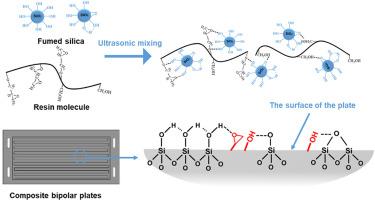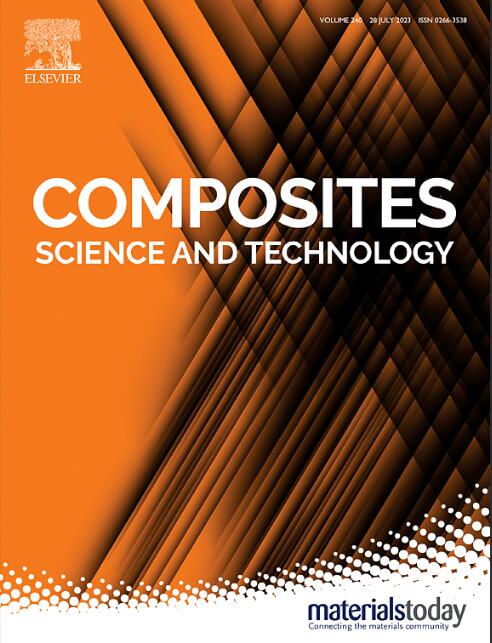Fumed silica additives enables tunable wettability of the resin for improved composite bipolar plate
IF 8.3
1区 材料科学
Q1 MATERIALS SCIENCE, COMPOSITES
引用次数: 0
Abstract
Composite bipolar plates (CBP) composed of resin and conductive filler are critical components in proton exchange membrane fuel cell (PEMFC) for achieving mechanical strength and electrical conductivity. The conductive filler entirely enveloped by resin is of significance for the flexibility of the CBP; while connected resin blocks the continued conductive channels and thus weakens the electrical properties of CBP. Herein, we propose a trade-off method between flexibility and conductivity of the CBP by wettability regulations of the resin, in which fumed silica additives are introduced into epoxy as composite adhesives. The abundant hydrogen bonds are demonstrated to be well-formed between epoxy and fumed silica for decreasing surface free energy (SFE) between resin and graphite. As a result, the composite adhesive with 2 % fumed silica delivers moderate wettability enabling much improved CBP, which exhibits high electrical conductivity of 233.33 S cm−1 as well as flexural strength of 66.4 MPa. Moreover, the CBP also delivers improved areal specific resistance (5.34 mΩ cm2), thermal conductivity (10.58 W (m K)−1), and corrosion behaviors (0.0701 A cm−2) which guarantee the operation of the PEMFC. This work provides new insight from the wettability regulation of resins for improved CBP, which is an easy-operating method and has great potential for application in practical CBP fabrication.

气相二氧化硅添加剂可调节树脂的润湿性,从而改善复合双极板的性能
由树脂和导电填料组成的复合双极板(CBP)是质子交换膜燃料电池(PEMFC)中实现机械强度和导电性能的关键部件。完全被树脂包裹的导电填料对 CBP 的柔韧性具有重要意义,而连接的树脂则会阻塞持续的导电通道,从而削弱 CBP 的电气性能。在此,我们提出了一种通过调节树脂的润湿性来权衡 CBP 的柔韧性和导电性的方法,即在环氧树脂中引入气相二氧化硅添加剂作为复合粘合剂。实验证明,环氧树脂和气相二氧化硅之间形成了丰富的氢键,从而降低了树脂和石墨之间的表面自由能(SFE)。因此,含有 2% 气相二氧化硅的复合粘合剂具有适度的润湿性,从而大大提高了 CBP 的性能,表现出 233.33 S cm-1 的高导电性和 66.4 MPa 的抗折强度。此外,CBP 还改善了比电阻(5.34 mΩ cm2)、热导率(10.58 W (m K)-1)和腐蚀行为(0.0701 A cm-2),从而保证了 PEMFC 的运行。这项工作从树脂的润湿性调节方面为改进 CBP 提供了新的见解,是一种易于操作的方法,在实际 CBP 制备中具有巨大的应用潜力。
本文章由计算机程序翻译,如有差异,请以英文原文为准。
求助全文
约1分钟内获得全文
求助全文
来源期刊

Composites Science and Technology
工程技术-材料科学:复合
CiteScore
16.20
自引率
9.90%
发文量
611
审稿时长
33 days
期刊介绍:
Composites Science and Technology publishes refereed original articles on the fundamental and applied science of engineering composites. The focus of this journal is on polymeric matrix composites with reinforcements/fillers ranging from nano- to macro-scale. CSTE encourages manuscripts reporting unique, innovative contributions to the physics, chemistry, materials science and applied mechanics aspects of advanced composites.
Besides traditional fiber reinforced composites, novel composites with significant potential for engineering applications are encouraged.
 求助内容:
求助内容: 应助结果提醒方式:
应助结果提醒方式:


